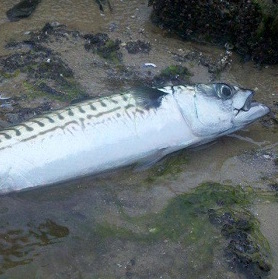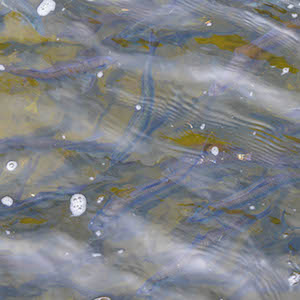The Cape Cod Canal is a very interesting place to wet a line. Actually, I really cannot think of a more unique place to fish, especially from shore.
In this section I am going to share with you an overview of the Canal.
We'll take a look at the Canal's structure and life. At the end we'll talk about how striped bass use the Canal for migration and feeding purposes.
The Canal's Dramatic Bottom Structure
In the open ocean (or even in places like Cape Cod Bay and Buzzard’s Bay) it is not unusual to go miles without seeing or marking anything exciting. In these areas the sea floor is often structure-less, extending in every direction without any significant depth changes.
The Canal, on the other hand, is an ever changing, ever moving marine ecosystem. The Cape Cod Canal’s bottom is packed with depth changes, boulders, deep ditches and high rocky peaks and ledges.
Just take a look at this sonar shot I took of one of my favorite Canal rips, to get a sense of what I mean.
Toss in an old ship wreck or two, some lobster pots and a whole bunch of who knows what else and you have a pretty extreme striped bass fishing environment. It's no wonder that hundreds (if not thousands!) of jigs, lures, hooks and tackle are sacrificed to the "Canal Gods" each season.
Marine Life at the Canal
I am sure that any veteran Canal angler you speak to can add a few species to this list. The Canal is quite literally a cornucopia of life.
Striped Bass Migration & Feeding Habits

Striped bass frequently visit the Canal May through October. Bass use the Canal for a couple of important reasons.
During the spring and fall, certain schools of striped bass use the Canal as a migratory "shortcut." In May and June, large bio masses of striped bass swim up from the south, and use the Canal to access Cape Cod Bay and points north.
In the fall, bass migrating south will pass through the Canal During September, October and even into November. This saves quite a few miles - contrasted to swimming offshore all the way around the arm of Cape Cod.
Sometimes during the summer, especially when there's a lot of mackerel around, schools of bass will take up "residence" in the canal. After all, if the feeding is good, why leave?
Sometimes the canal is loaded with fish, and sometimes it's nearly vacant. Nevertheless, you always a chance of catching a big striper in the canal anytime May through October.
Bait in the Canal

Each season thousands of mackerel, herring and menhaden invade the Canal. Bass are quick to pounce on these prime feeding opportunities, pinning these large prey items against the Canal's banks and literally gorging themselves at the feet of fishermen.
The main population of Atlantic mackerel usually resides off the East entrance to the Cape Cod Canal, out in Cape Cod Bay. If the stars align a few thousand or so of these speedsters will venture deep into the Canal (probably for feeding purposes of their own). This can turn into an epic striped bass feeding frenzy, if the tides are right and the bass are around.
During the summer of 2010 tinker mackerel (young Atlantic mackerel) spent the entire spring and summer feeding in the Canal. The striped bass fishing, in turn, was much better than usual throughout July and August.
During this memorable year it was not strange to find acres of bass feeding on the surface even during the middle of a hot August afternoon. Maybe we'll get lucky and this will happen again sometime soon.
River herring also migrate into the Canal and up the Bournedale herring run each spring to spawn. Same story with the herring - if bass are around when they come through, epic blitzes can take place.

Menhaden that are heading to northern locales will cut through the Big Ditch and subsequently gain the attention of big schools of migrating stripers.
I just barely missed an incredible striped bass blitz during 2012 in which hordes of big stripers scared thousands of menhaden up and directly into the Canal rocks. When I arrived "post-blitz" I was greeted by many dead and rotting menhaden, scattered throughout the nooks and crannies of the Canal rip-rap.
This fishing can be lights out when big schools of big bass gang up on big prey items like mackerel, herring and menhaden. In these circumstances the bass are very aggressive.
Huge top water feeding frenzies and incredible surface action is the norm during such a blitz. Top water plugging is the most fun way to catch these impressive fish.
We'll talk more about Canal blitzes and topwater plugging later on in the eCourse.

